
Deir el-Bahari or Dayr al-Bahri is a complex of mortuary temples and tombs located on the west bank of the Nile, opposite the city of Luxor, Egypt. This is a part of the Theban Necropolis.

Mentuhotep II, also known under his prenomen Nebhepetre, was an ancient Egyptian pharaoh, the sixth ruler of the Eleventh Dynasty. He is credited with reuniting Egypt, thus ending the turbulent First Intermediate Period and becoming the first pharaoh of the Middle Kingdom. He reigned for 51 years, according to the Turin King List. Mentuhotep II succeeded his father Intef III on the throne and was in turn succeeded by his son Mentuhotep III.

Sehertawy Intef I was a local nomarch at Thebes during the early First Intermediate Period and the first member of the 11th Dynasty to lay claim to a Horus name. Intef reigned from 4 to 16 years c. 2120 BC or c. 2070 BC during which time he probably waged war with his northern neighbor, the Coptite nomarch Tjauti. Intef was buried in a saff tomb at El-Tarif, known today as Saff el-Dawaba.
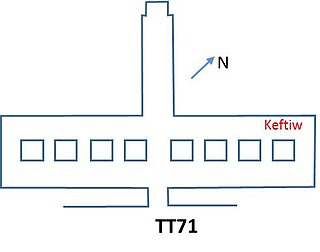
Theban Tomb TT71 is located in the Theban Necropolis, on the west bank of the Nile, opposite to Luxor. It was the tomb chapel of Senenmut, who was the steward and architect of Hatshepsut. The chapel is located in the necropolis area around Sheikh Abd el-Qurna. Previously the tomb was accessible and for most of this time the target of numerous investigations and intrusions, although early on already heavily destroyed. The tomb was visited already early. In the first half of the nineteenth century, John Gardner Wilkinson, Robert Hay and J. Wild copied scenes, although the decoration was already badly destroyed. Richard Lepsius (1842–45) took the false door to Berlin and copied some inscribed bricks. Only in 1906 Kurt Sethe copied all inscriptions. In 1930–31 Herbert Winlock cleared the whole tomb. Winlock found the fragments of a smashed sarcophagus.

KV4 is a tomb in the Valley of the Kings (Egypt). The tomb was initiated for the burial of Ramesses XI but it is likely that its construction was abandoned and it was not used for Ramesses's interment. It also seems likely that Pinedjem I intended to usurp this tomb for his own burial, but that he too abandoned the plan. KV4 is notable for being the last royal tomb that was quarried in the Valley and because it has been interpreted as being a workshop used during the official dismantling of the royal necropolis in the early Third Intermediate Period.

The Valley of the Kings, also known as the Valley of the Gates of the Kings, is an area in Egypt where, for a period of nearly 500 years from the Eighteenth Dynasty to the Twentieth Dynasty, rock-cut tombs were excavated for pharaohs and powerful nobles under the New Kingdom of ancient Egypt.

The Theban Necropolis is a necropolis on the west bank of the Nile, opposite Thebes (Luxor) in Upper Egypt. It was used for ritual burials for much of the Pharaonic period, especially during the New Kingdom.
The Theban Tomb TT36 is located in El-Assasif, part of the Theban Necropolis, on the west bank of the Nile, opposite to Luxor. It is the burial place of the ancient Egyptian Ibi, who was "Chief Steward of the Adorer of the God", during the reign of Psamtik I during the 26th dynasty.

The Theban Tomb TT37 is located in El-Assasif. It forms part of the Theban Necropolis, situated on the west bank of the Nile opposite Luxor. The tomb is the burial place of the ancient Egyptian Harwa, who was Chief Steward of the God's Wife of Amun, Amenirdis I, during the 25th Dynasty. Harwa was the son of the scribe Pedemut and his wife Estawert.
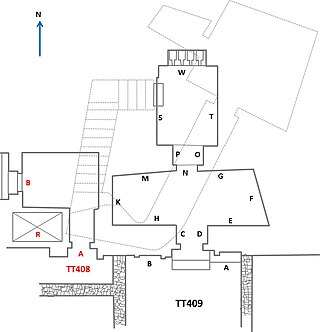
The Theban Tomb TT409 is located in El-Assasif, part of the Theban Necropolis, on the west bank of the Nile, opposite to Luxor. It is the burial place of the ancient Egyptian Samut called Kyky, who was Accountant of Cattle of the Amun domain, during the reign of Ramesses II during the Nineteenth Dynasty.

The Theban Tomb TT319 is located in Deir el-Bahari, part of the Theban Necropolis, on the west bank of the Nile, opposite to Luxor. The tomb belongs to the king's wife Neferu II, wife of the ancient Egyptian king Mentuhotep II. Neferu was the daughter of Queen Iah and Intef III.
Ipi was an Ancient Egyptian vizier of the early Middle Kingdom. His only secure attestation known today is his Theban Tomb (TT315) .The tomb was found in the rocks of Deir el-Bahari overlooking the funerary complex of Mentuhotep II. It consisted of a great courtyard, a corridor, a chapel and a burial chamber. The corridor and chapel were found undecorated and only the burial chamber had painted decorations, religious texts and the titles and name of Ipi on its walls. The burial chamber housed a sarcophagus, sunk into the floor.

Theban Tomb TT223 is located in South El-Assasif. It forms part of the Theban Necropolis, on the west bank of the Nile opposite Luxor. The site is the burial place of the ancient Egyptian Karakhamun. It was first discovered in 1820 by Wilkinson, Hey and Burton, then by Lepsius, it was reopened in 2001.

Meru was an Ancient Egyptian official under king Mentuhotep II in the Eleventh Dynasty, around 2000 BC. Meru was overseer of sealers at the royal court and therefore one of the highest state officials.

The Theban Tomb TT214 is located in Deir el-Medina, part of the Theban Necropolis, on the west bank of the Nile, opposite to Luxor.
Intef (Antef) was an Ancient Egyptian general of the 11th Dynasty, around 2000 BC, under king Mentuhotep II. His main title was overseer of troops often translated as general. Other titles include royal sealer and sole friend.
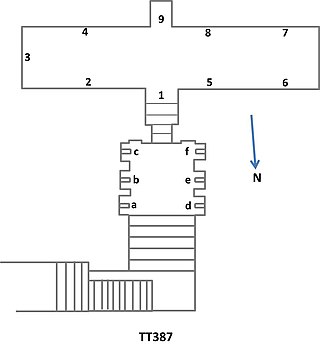
The Theban Tomb TT387 is located in El-Assasif, part of the Theban Necropolis, on the west bank of the Nile, opposite to Luxor. It is the burial place of Meryptah, the royal scribe of the table of the Lord of the Two Lands, and the Governor of the Desert Lands for the Southern Deserts. His wife is a Lady of the House and a Chantress of Amun. Her name is Nebkhentu.
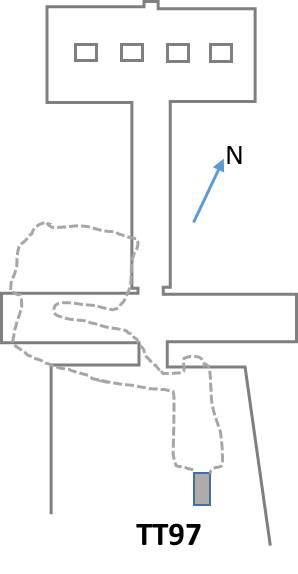
The Theban Tomb TT97 is located in Sheikh Abd el-Qurna, part of the Theban Necropolis, on the west bank of the Nile, opposite to Luxor. The tomb belongs to an ancient Egyptian named Amenemhat, who was the High Priest of Amun at Karnak, during the reign of pharaoh Amenhotep II of the 18th Dynasty. Amenemhat was the son of the wab-priest and "Overseer of the sandal makers of Amun", Djehutyhotep.
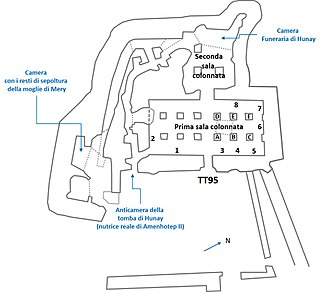
The Theban Tomb TT95 is located in Sheikh Abd el-Qurna, part of the Theban Necropolis, on the west bank of the Nile, opposite to Luxor. The tomb belongs to an ancient Egyptian named Mery, who was a High Priest of Amun at Karnak, during the reign of pharaoh Amenhotep II of the 18th Dynasty. Mery was the son of the First Prophet of Min of Koptos (Qift) named Nebpehtire and the Lady Hunayt. Mery's wife was named Dey.
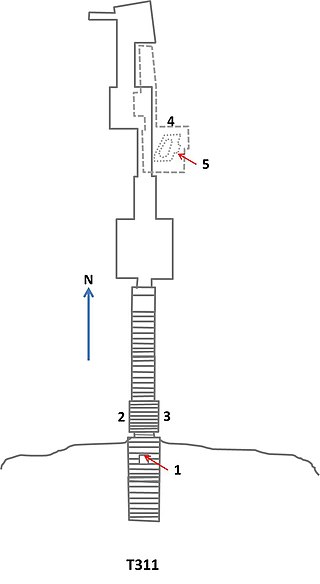
The Theban Tomb TT311 is located in Deir el-Bahari, part of the Theban Necropolis, on the west bank of the Nile, opposite to Luxor. The tomb belongs to the Seal-bearer of the King of Lower Egypt named Kheti. The tomb was excavated by Winlock during the 1923 excavations on behalf of the Metropolitan Museum of Art. Kheti had a tomb near the funerary temple of king Mentuhotep II. The tomb was found heavily destroyed but there are still many remains of reliefs showing that it was once decorated. The burial chamber was better preserved and was also decorated.

















